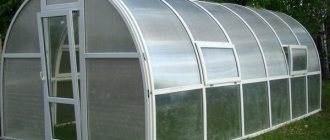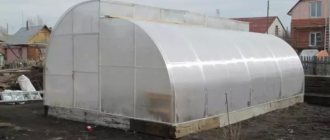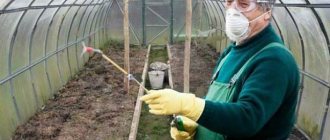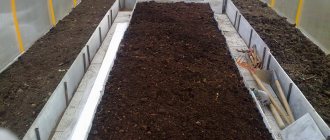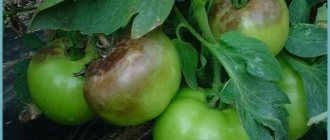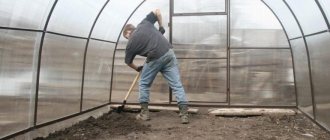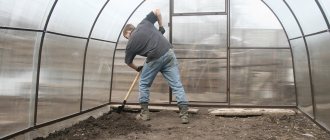Plants living in a greenhouse are susceptible to attack by various pests and often suffer from all kinds of diseases. One of them is late blight. This disease is very dangerous; it can ruin all your painstaking work in growing plants and obtaining a rich harvest.
However, this can be avoided - it is necessary to prepare the greenhouse in the fall. How to treat a greenhouse against late blight in the fall? Let's look at the main methods.
How to treat a greenhouse against late blight in the fall
Signs and danger of late blight in a greenhouse
Late blight is one of the dangerous fungal diseases that has recently become increasingly widespread on land. This is especially true for the middle zone with its unpredictable weather conditions.
The disease is caused by spores of the fungus of the same name. Most often it affects nightshade crops such as tomatoes, potatoes, eggplants, and peppers. He is also a frequent visitor to the greenhouse where heat-loving crops grow.
One of the first signs of plant damage by late blight is the appearance of brown or gray-black spots on the back of the leaves. If measures are not taken in a timely manner, the disease will spread first to the shoots of the plant, and then to its fruits.
For example, tomatoes develop black or gray hard spots that eventually begin to rot. Often late blight on tomatoes manifests itself in rotting of the fruit near the stalk. In any case, vegetables lose their commercial characteristics and cannot be stored. In advanced forms, late blight can destroy up to 70% of the crop.
Greenhouses are the best place for the spread of spores of harmful fungi. High humidity and sudden changes in day and night temperatures only contribute to its reproduction. In cool summers, plants in a greenhouse become an excellent target for attack.
Instructions: how to process a polycarbonate structure?
Cleaning in the greenhouse must be carried out according to a certain algorithm. This will increase the efficiency of processing and protect against the consequences of the use of toxic substances.
Cleaning
Before you start processing anything, you need to take out all the trash. This can be household garbage, bags, and dry leaves. It is also necessary to remove all infected plants. But the polycarbonate structure itself does not need to be disassembled.
Disinfection of land
After harvesting, it is necessary to remove the contaminated layer of soil. The thickness of the removed layer, as a rule, is 7 - 10 cm. In the fall, a point for digging up the soil is added to remove all the larvae. Then it is necessary to treat with one of the drugs: phytosporin, pharmacoid, copper sulfate solution.
Frame and walls
You can treat the polycarbonate frame with a simple soap solution. The main thing is to use soft rags.
After the soap solution, treatment is carried out simply with a damp cloth. It is necessary to process it from the inside and outside, while simultaneously inspecting the frame for rust.
If there is rust, it is scraped off and a layer of paint is applied on top.
Soil protection and fertilization
After everything has been processed, you need to fill it with a fresh layer of soil and apply fertilizer. Next, preventive measures are taken.
What needs to be done in the fall in the greenhouse after late blight
What to do in the fall in a greenhouse where late blight was rampant in the summer. This question worries many vegetable growers who do not want to continue to fight for the harvest next year, treating plants with all sorts of means that are not always effective and safe for health.
Preparatory work
Before you start treating greenhouses and greenhouses against late blight in the fall, they should be prepared. They remove the remains of plants, weed weeds, cut off the twine for tying shoots, and remove all removable structures and supports from the greenhouses. Remove the film covers. Replacing it will be cheaper than trying to wash and disinfect it.
Attention! Any remains of vegetation, if there is a suspicion of late blight on vegetables, should not be placed in compost heaps. There is a high probability of fungal infection of large areas when humus is used as fertilizer.
Then the internal surface and structural elements are thoroughly cleaned. You can use a regular solution of laundry soap. To do this, the block is grated on a fine grater and diluted in 10 liters of water. It is not recommended to use synthetic detergents, as they contain a large amount of substances harmful to the human body that will remain in the soil.
Fighting methods and popular remedies
One of the main methods of combating late blight is autumn treatment of the greenhouse. Proper treatment will not only help cope with this scourge and protect your harvest in the future, but will also prepare a home for plants for spring, and you will not have to improve it before the start of the summer season.
The greenhouse is disinfected in various ways:
On a note! The greatest effect comes from the integrated use of all types of greenhouse treatment in the fall, and not just one.
To treat soil in a greenhouse, chemical or temperature methods are most often used. The structure itself must be treated with chemicals.
Greenhouse elements need to be treated with chemicals
Table. Anti-late blight preparations suitable for treating greenhouse structures.
| Means | Description |
| Sulfur smoke bombs | This is one of the most popular ways to deal with late blight. Smoke penetrates well into all areas of the greenhouse, getting into even the most secluded corners. The parasitic fungus simply does not have a chance to survive. However, sulfur dioxide, which appears during the combustion of a sulfur smoke bomb, is dangerous to human health. Therefore, you should not be in the greenhouse during fumigation. The doors should be closed tightly, and in the fall you should not enter the room at all for 3-4 days. |
| Copper sulfate | This is also a dangerous enemy for late blight. Vitriol copes well with this parasite. The entire greenhouse should be thoroughly coated with a solution of this substance and the soil should be spilled. For watering, vitriol is diluted in a proportion of 5 g per 10 liters of water, and for washing the greenhouse the solution should be more saturated - 100 g per 10 liters. |
| Soap solution | The safest method of combating late blight in terms of impact on human health. Although, using only this method, you are unlikely to easily cope with the parasite. However, before using other means, it doesn’t hurt to wash the greenhouse with soap. At the very least, this will help remove all surface dirt, which means it will be easier for strong chemicals to reach the pathogens. |
| Fungicides | Sold at any gardening and hardware store. Their selection is quite large. Some of them can be used not only for spraying plants, but also for autumn treatment of greenhouse structures in order to combat parasites and fungi, including late blight. |
| Bleaching powder | As they say, cheap and cheerful. Bleach is the best option for treating wood-framed greenhouses because it protects the wood from rot and woodworms. It is enough to dilute just 400 g of the substance in a 10-liter bucket of water and let it brew for about 4 hours, and the terrible poison for late blight is ready. Coat the entire surface of the greenhouse with liquid, and then the wooden frame. After treatment, the structure is closed for 2-3 days. |
But not only the greenhouse structure itself needs to be treated if you want to get rid of late blight with a 100% guarantee. Remember that spores can also overwinter in the ground, so treat that too in the fall.
Basic methods of soil treatment against late blight.
- Biological . This is the safest method from an environmental point of view, since late blight is fought by organisms living in nature. In addition, microorganisms will restore biological balance in the soil. For the method to start working, you simply need to populate them in the soil by adding humus and compost. Also for this purpose, stores sell special preparations such as “Shining” or “Baikal EM-1”. However, this method is often ineffective if late blight affects most of the greenhouse and soil. It is advisable to use a biological method of control in conjunction with others. Fitosporin-M will also help defeat this scourge.
Instructions for use of the EM-preparation “Shine-2”
"Baikal EM-1"
Fitosporin-M
Prices for "Fitosporin-M"
phytosporin
Potassium permanganate
Timing of greenhouse treatment after late blight in autumn
You can treat the greenhouse in the fall against pests and late blight at any time convenient for the gardener. There are only two conditions:
- the harvest must be harvested, and the greenhouse itself must be prepared for processing;
- the air temperature should not fall below 10-12 degrees Celsius, since at lower temperatures some drugs lose their effectiveness.
As a rule, most gardeners treat greenhouses and greenhouses against late blight in the first two months of autumn - September or October.
How to properly prepare a greenhouse for wintering in the fall - useful tips
We have given detailed instructions on how and with what to wash a polycarbonate greenhouse in the fall, but these measures are not enough to prepare for winter. It is also important to strengthen the structure, insulate it if necessary, and provide lighting.
If plants will be planted in the greenhouse for the winter in the fall, the foundation should be insulated with polystyrene foam boards, wooden panels, covered with film, and a mound of earth should be made. It is recommended to install a second layer of film, thin polycarbonate, inside. The air gap between the layers retains heat well.
The photo shows an example of insulating a structure in the fall
In regions with a harsh climate, you should consider heating the greenhouse in the fall: stove, electric, water. The easiest way to install ultraviolet heaters or fan heaters. For the full development of plants, do not forget to provide additional lighting; the set of lamps for lighting must completely duplicate the solar spectrum. To avoid damage to the greenhouse from heavy snow loads, vertical supports should be placed inside every 1.5-2 m.
Processing rules
It is advisable to carry out late blight treatment in the fall before the air temperature drops to 10 degrees Celsius. The exception is their disinfection using low temperatures.
Since greenhouses are closed spaces, you should not wait for favorable weather conditions. But you should prepare gloves and closed clothing. When working with chemicals and sulfur bombs, respiratory protection will not hurt. Before carrying out work, children and pets are removed from the treatment area.
Adviсe
In order for the fight against late blight to be effective, you need to adhere to some recommendations:
- When processing with biological and home remedies, you need to take into account the temperature in the greenhouse. It must be at least +10 degrees, otherwise the action of microorganisms in the preparation may be ineffective.
- You cannot use honey-containing preparations in the greenhouse during the ripening of fruits - they are poisonous and do not evaporate for a long time from a closed room. All aggressive chemicals can only be used in the fall after harvest.
- At the time of processing, pay special attention to cracks and gaps in the structure - there is a good environment for the development of late blight spores.
- When treating plants against late blight during the growing season, it is better to use folk remedies. Use garlic, wood ash, iodine, etc. for disinfection. Why cook them according to recipes and spray them.
- Steaming the soil helps a lot; you only need to pour boiling water on the soil on the ridges during spring digging. And also when making ridges in a greenhouse in the spring, you can add marigolds and calendula to the ground, and then dig them up - late blight is afraid of these flowers.
- All processing procedures should be performed with gloves, goggles and a respirator to protect the respiratory system and skin from harmful substances.
Fighting late blight is not an easy task, and some gardeners solve this problem in a radical way - by installing a greenhouse in a new location. At the same time, if disinfection is carried out in a timely manner in the fall, and preventive work in the summer, then the old greenhouse structure can be restored to its proper condition, eliminating the late blight pathogens in it.
Prevention measures
One of the main measures to prevent late blight is maintaining cleanliness in greenhouses. Timely weeding, inspection of plants and removal of diseased shoots will help preserve the harvest. There are no compost heaps near greenhouses.
It is also important to maintain the humidity level not higher than 70-75%. To do this, greenhouses are regularly ventilated and are not closed less than 30-40 minutes after watering. In the fall, when damaged plants are found, they are burned or taken off site.
The best varieties of tomatoes for the greenhouse, resistant to late blight
There are no varieties and hybrids of tomatoes that are absolutely not susceptible to the disease. But every year more and more varieties appear that are more resistant to late blight than others. For example:
- Oak is a determinate variety with a compact bush. Characterized by early ripening (85-100 days). Unpretentious and frost-resistant. The fruits are small, weighing up to 100 g, collected in a cluster, and have a good taste. Tomatoes are particularly resistant to late blight.
- Orange miracle is an early ripening determinate variety of tomatoes. Ripening period is up to 100 days. The fruits are large (up to 150 g), pear-shaped, orange in color, a high-yielding variety. Due to their high beta-carotene content, they are very useful. The taste is excellent, the sweetish fruits are suitable for fresh consumption.
- Lark is a hybrid variety of determinate species, bush height up to 90 cm. Ultra-early ripening (80 days after germination), fruits 100-120 g. Excellent, sweetish taste, bright red color, used for salads and canning. The hybrid is able to set fruit even in unfavorable conditions.
- De Barao is an indeterminate variety. Despite the late ripening of tomatoes (115-120 days), it has strong immunity against late blight. Plants are tall - up to 2 meters; formation and pinching of tomatoes is required. The fruits are plum-shaped, there are varieties with red, yellow, black fruits, weighing 70-90 g, universal use.
- Cardinal is a mid-season indeterminate variety, up to 2 m high. Ripening time is 110-115 days. Large fruits weighing 400-900 g; up to 10 tomatoes can form on one cluster. The variety is high-yielding, cold-resistant, the fruits are fleshy and have an excellent taste. They are distinguished by high keeping quality and do not crack.
- Gardeners note that late blight is a serious disease that can destroy most of the crop, so it is easier to prevent than to treat.
Carrying out preventive measures and alternating different methods of combating the disease will help preserve the plants and get an excellent harvest of tomatoes.
What it is
Phytophthora is a fungus that attacks and destroys plants. This fungus and its dangerous qualities have been known to scientists for a long time. The scientific name Phytophthora translates to “plant destroyer.”
The disease caused by the fungus is called late blight. Almost no plant is immune to this scourge, but crops from the nightshade family are especially susceptible to the harmful effects of the fungus.
Tomatoes, bell peppers, and potatoes are the first to be affected and almost always die. Berry crops are also susceptible to the disease. For example, this fungus can quickly destroy strawberries.
How to treat a greenhouse against late blight in spring
Cleaning a greenhouse includes several stages:
- Disinfect the soil. This is the most troublesome event that must be carried out every spring. If the greenhouse is small, then you can pour boiling water over the entire soil. Some of the spores will be destroyed. However, there is no 100% effective way to disinfect soil. The only correct method is to replace the soil. If you can’t remove everything, then a top layer 5-7 cm thick is definitely needed. After digging up the greenhouse soil, scatter it around the garden or garden, or you can mix it with manure. After 3-4 years, such soil will be ready for use again. The soil that is left in the greenhouse without a top layer is dug up and fertilized. In early spring, add manure or ready-made compost.
How does fungus work?
Phytophthora is a microorganism that spreads through zoospores. Zoospores easily tolerate winter frosts, “hiding” in stale leaves, plant debris, old tubers, mulch and upper layers of soil.
During the cold period, the fungus “sleeps”, but as soon as conditions favorable for it arise, the microorganism becomes active, infects the plant and begins to multiply. In a short period of time, late blight can “capture” the entire greenhouse and even escape beyond the boundaries of the greenhouse.
Zoospores develop at temperatures above +10 degrees Celsius. However, for rapid and active growth, the fungus needs high humidity, not lower than 75%. And these are precisely the conditions that appear in greenhouses in early spring.
